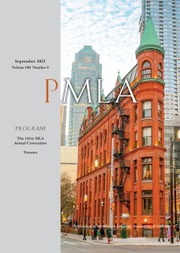No CrossRef data available.
Article contents
The “Man-Eater” Variant to “A Hunger-Artist”
Published online by Cambridge University Press: 17 October 2024
Abstract
An abstract is not available for this content so a preview has been provided. Please use the Get access link above for information on how to access this content.
- Type
- Little-Known Documents
- Information
- Copyright
- Copyright © 2024 The Author(s). Published by Cambridge University Press on behalf of Modern Language Association of America
References
Works Cited
Balint, Benjamin. Kafka's Last Trial: The Case of a Literary Legacy. W. W. Norton, 2018.Google Scholar
Benjamin, Walter. “Letter to Gershom Scholem on Franz Kafka.” Selected Writings, 1935–1938, vol. 3, Belknap Press, 2002, pp. 322–29.Google Scholar
Butler, Judith. “Lost and Unfounded.” Jewish Currents, vol. 75, no. 2, spring 2021, pp. 136–41.Google Scholar
Butler, Judith. “Who Owns Kafka?” London Review of Books, vol. 33, no. 5, 3 Mar. 2011, pp. 3–8.Google Scholar
Caygill, Howard. “Kafka's Exit: Exile, Exodus and Messianism.” Aesthetics and the Work of Art: Adorno, Kafka, Richter, edited by Bolla, Peter de and Uhlig, Stefan H., Palgrave Macmillan, 2008, pp. 126–46.Google Scholar
Dürbek, Gabriele, and Dunker, Axel, editors. Postkoloniale Germanistik: Bestandsaufnahme, theoretische Perspektiven, Lektüren. Aisthesis, 2014.Google Scholar
Gosetti-Ferencei, Jennifer Anna. Exotic Spaces in German Modernism. Oxford UP, 2011.CrossRefGoogle Scholar
Gray, Ronald D. Introduction. Kafka: A Collection of Critical Essays, edited by Gray, Prentice-Hall, 1962, pp. 1–11.Google Scholar
Kafka, Franz. “Ein Hungerkünstler.” Drucke zu Lebzeiten, S. Fischer Verlag, 1994, pp. 333–49.Google Scholar
Kafka, Franz. Letter to Hans Mardersteig. 1922. Kafka-Lektüren, by Neumann, Gerhard, Walter de Gruyter, 2013, pp. 507–08.Google Scholar
Kafka, Franz. Letter to Max Brod. 22 July 1912. Breifwechsel, edited by Pasley, Malcolm, S. Fischer Verlag, 1989, p. 108. Vol. 2 of Max Brod, Franz Kafka: Eine Freundschaft.Google Scholar
Kafka, Franz. Nachgelassene Schriften und Fragmente. Vol. 2, edited by Schillemeit, Jost, S. Fischer Verlag, 1992.Google Scholar
Pascal, Roy. Kafka's Narrators: A Study of His Stories and Sketches. Cambridge UP, 1982.Google Scholar
Pasley, Malcolm. “Asceticism and Cannibalism: Notes on an Unpublished Kafka Text.” Oxford German Studies, vol. 1, no. 1, 1966, pp. 102–13.CrossRefGoogle Scholar
Thompson, Mark Christian. Kafka's Blues: Figurations of Racial Blackness in the Construction of an Aesthetic. Northwestern UP, 2016.CrossRefGoogle Scholar
Zilcosky, John. Kafka's Travels: Exoticism, Colonialism, and the Traffic of Writing. Palgrave Macmillan, 2003.CrossRefGoogle Scholar


